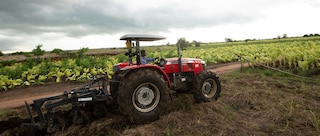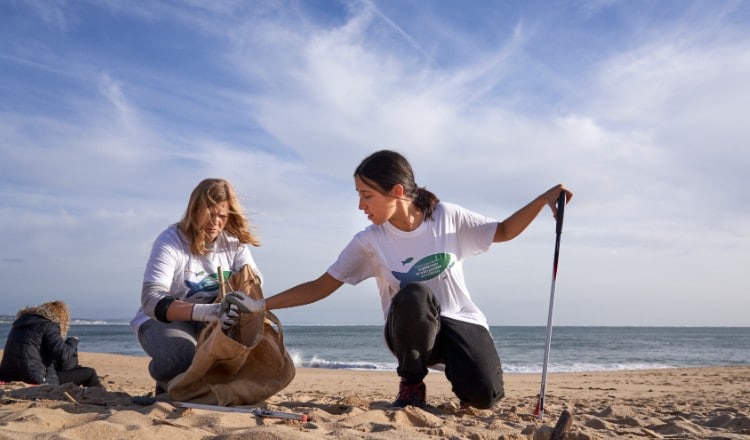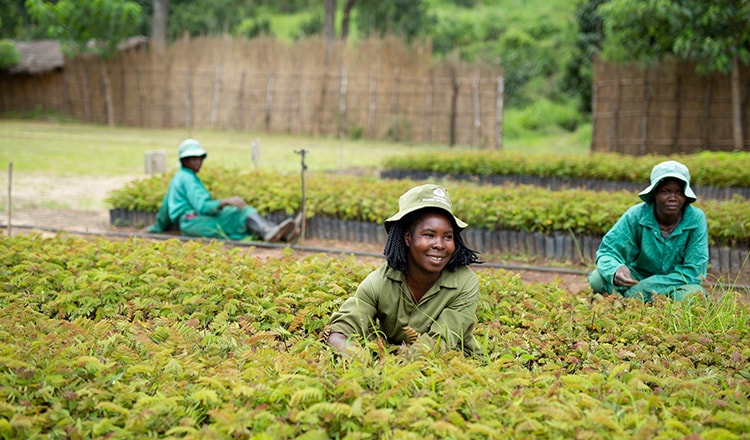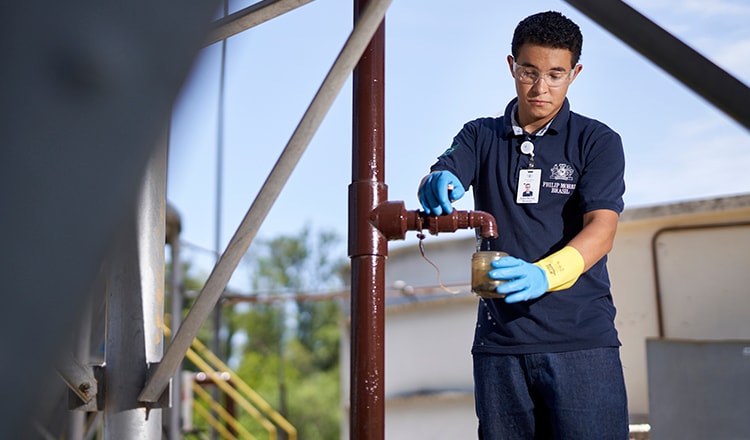Integrated Report 2019
| INTEGRATED REPORT 2019 |
Recent global scientific studies indicate that 1 million plant and animal species are at risk of extinction, with significant insect population losses in the last generation and thousands of species already extinct.1 These losses have an impact on the health and livelihoods of human populations since we collectively depend on the ecological services of soils, land, forests, and water rich in biodiversity. Companies have an important role to play in tackling losses by promoting conservation in partnership with organizations such as the International Union for Conservation of Nature (IUCN) and the World Business Council for Sustainable Development.
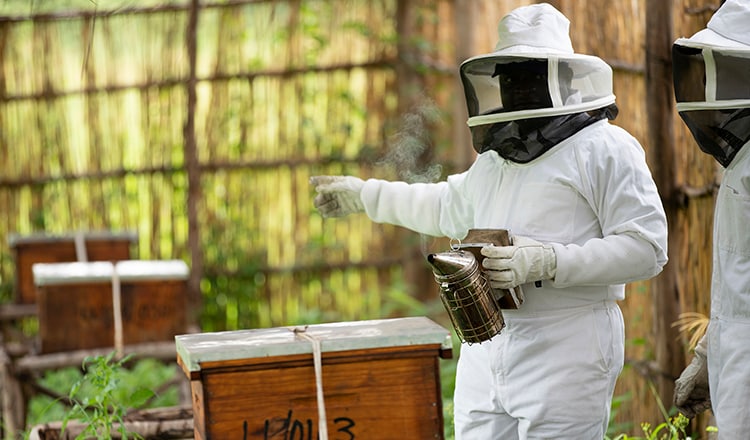
Topic description
For PMI, biodiversity is about reducing the negative impacts of our operations and sourcing activities on habitats and ecosystems and looking for contributions we can make to biodiversity. This includes the careful management of land use, protection of soil quality, and prevention of pollution. Post-consumer waste resulting from the use of our products is described separately.
Why it is important to us and our stakeholders
From a societal perspective, biodiversity is essential to human life as ecosystems contribute to human health, well-being, and the economy. Healthy natural habitats provide vital ecosystem services, such as pollination, biological pest control, and the regulation of nutrient cycles. Unsustainable natural resource use can lead to soil loss and ground instability, diminished amenity, and a loss of economic value for society. Often, it is the world’s poorest communities that are particularly vulnerable to the negative impact of changes in climate, biodiversity, and ecosystem functions.
From PMI’s standpoint, biodiversity is essential to securing the supply of agricultural materials necessary for our products. A key risk we face in this regard is upstream in our agricultural supply chain, where a loss of biodiversity could lead to diminished livelihoods for farmers and higher costs of production. These costs might include remediation measures to, for example, improve soil, protect crops, and adapt to climate change. In addition, our reputation could be eroded if we do not address stakeholders’ concerns regarding environmental issues around the world.
Achieving our aims
In the past, our efforts to conserve biodiversity were focused on the protection of forests, a well-known issue globally. Lately, biodiversity has been identified as a sustainability material issue both by our stakeholders and through our own assessments.
Our Environmental Commitment requires PMI to jointly deliver biodiversity conservation programs with stakeholders, in particular suppliers, farmers, and environmental NGOs. Our Zero Deforestation Manifesto describes our ambition to enhance biodiversity in forest ecosystems that relate to our supply chains, particularly agricultural, paper, and pulp-based materials. This is achieved by applying our RSP and GAP measures, leveraging opportunities to preserve natural capital stocks while creating value for society and our business. Finally, our anti-littering policy seeks to address the impact of cigarette and heated tobacco units littering.
In our tobacco and clove supply chains, PMI’s GAP program requires biodiversity conservation in several ways and specifically embraces five measurable standards.2 By 2020, we aim to have in place sustainable sourcing of biomass fuels (verifiable and third-party audited) as part of our commitment to halt deforestation and conserve biodiversity.
More specifically in our tobacco supply chain, we work with our suppliers on the restoration of forests. In the coming years, we aim to go beyond sustainable wood fuel sourcing for tobacco curing and enhance biodiversity and natural habitats by restoring hundreds of hectares of forestland. To deliver the greatest impact, our biodiversity management integrates habitat conservation, water use and quality, soil conservation, climate change adaptation, waste management, pest management, and landscape diversification. Our water stewardship strategy contributes to maintaining biodiversity and soil health, for example. Our program on integrated pest management aims to guide our suppliers and farmers to protect the natural capital that supports their livelihoods by reducing the use of crop protection agents. Beyond this, we also leverage our purchasing policies: By 2020, we aim to eliminate the purchase of tobacco that contains residues indicating the use of highly hazardous pesticides (HHPs, as defined by the WHO and FAO).
To tackle environmental impacts in our paper and pulp-based materials supply chain, all suppliers must comply with our RSP, which require them to systematically manage material environmental impacts associated with their operations and products, in line with the precautionary principle. The monitoring of suppliers of paper, pulp-based, and wood fiber materials is completed using our supplier due diligence platform (see the Sustainable supply chain management topic).
The governance arrangements guiding our management of all environmental impacts also apply to our biodiversity work (see here). In our tobacco supply chain, we leverage the close relationship between the 2,875 field technicians and the farmers to enhance the achievement of biodiversity goals under GAP. Moreover, neither our aims nor our management approach could be delivered without the contributions of a wide set of important stakeholders such as communities, suppliers, the business community, NGOs, and research partners. We use a global biodiversity mapping and benchmarking assessment alongside our deforestation risk assessment to plan actions to meet our targets.
Progress in 2019
Benchmarking and mapping our results
In 2019, we broadened our scope to assess the biodiversity footprint of our entire business. Trialing the GLOBIO methodology developed for the UN Environment Programme, we confirmed the importance of continuing to tackle the deforestation risks linked to tobacco curing and the procurement of wood-based products such as paper, carton, and cellulose acetate. This study highlighted the contribution of land used for tobacco farming to PMI’s biodiversity footprint: The area occupied by tobacco cultivation represents a loss of biodiversity compared with the equivalent undisturbed habitat. Our GAP program includes elements to conserve biodiversity in and around tobacco cultivation, and in 2020 we will evaluate how we can strengthen our efforts.
The risk of biodiversity loss and natural capital depletion in the areas in which we operate has led to a clear risk-based approach covering our operations as well as those of our supply chain partners. Our biodiversity initiatives occur in many parts of our business around the world. They are embodied in our corporate processes (e.g., product life-cycle assessments) and in the field (e.g., habitat conservation initiatives). Examples include training on sustainable curing fuels and exploring permaculture agriculture in Indonesia. PMI’s activities related to biodiversity conservation and enhancement take many forms, but most are underpinned by engagement and collaboration.
Enhancement of biodiversity and habitats
PMI’s business value is interconnected with stocks of natural capital; therefore, we support biodiversity initiatives that create a net positive impact. Community participation is at the heart of many such projects, with local people taking shared responsibility for the project’s planning and success. In Brazil, for instance, we are partnering with the Brazilian Agricultural Research Corporation (Embrapa). Focused on the training of small farmers and interventions at their properties, the initiative aims to improve biodiversity management in tobacco farming (see our case study on Brazil).
Protection: integrated pest management
Improving crop productivity creates value both for farmers and for PMI. Using less surface area to grow the same amount of crop frees up land for food crops, other income-generating activities, and, potentially, biodiversity conservation habitats. Our GAP and integrated pest management practices aim to protect the environment, as well as farmers’ health and safety.
Under our IPM, pests are controlled by a set of cultivation practices that include, as a last resort, the correct and safe application of crop protection agents. This results in healthy crops and safeguards biodiversity on the farm and in the local area.
We implement IPM in collaboration with the not-for-profit Centre for Agriculture and Bioscience International (CABI). To support IPM in all our tobacco communities, we have developed a toolbox that includes an IPM app and a website with country-specific management sheets for tobacco pests and diseases, as well as fact sheets on IPM and CPA management. Globally, farmers can access this information, helping them to identify appropriate practices. IPM plans have been implemented in all of PMI’s main tobacco-sourcing areas.
We are committed to eliminating the use of highly hazardous pesticides (HHPs) from our tobacco supply chain globally. Accordingly, CPAs classified by the World Health Organization (WHO) as Toxicity Class I are prohibited, and those in Class II are only to be used in well-justified cases. Having achieved our goal of no longer using WHO Toxicity Class I products, we continue to be committed to phasing out by 2020 the use of other HHPs, as defined by the UN’s Food and Agriculture Organization (FAO) and WHO. IPM is central to our Good Agricultural Practices, which are mandatory for all PMI tobacco suppliers and farmers. Our 2019 data, based on crop year 2018, shows that 89 percent of the tobacco crop was free of any other HHP residues, showing further progress against our target to eliminate them by 2020.
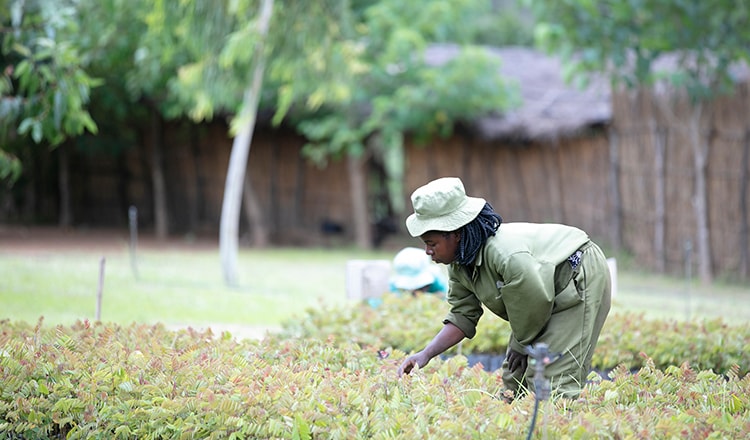
Genetically modified tobacco
In line with our Good Agricultural Practices (GAP) principles, genetically modified (GM) tobacco is not acceptable to PMI. We have solid programs in place to avoid any inadvertent introduction of GM tobacco into the products we commercialize.
In particular, we require each lot of tobacco seeds destined to PMI’s commercial production to be systematically sampled and tested, to ensure no GM tobacco is grown for our company. Specialized laboratories analyze the seeds sent by all our tobacco suppliers and provide the results directly to both PMI and the suppliers. Additionally, once the tobacco is grown and before we proceed with any purchase, we make sure that each lot of tobacco is tested – by the same specialized labs – to ensure it is not genetically modified. If any GM tobacco is detected, the lot is rejected and does not enter into PMI’s supply chain.
Next steps
Over the next year, we aim to gain a better understanding of PMI’s biodiversity footprint across our value chain, and we plan to select a series of metrics that are relevant for our business. We will continue to focus on habitat restoration and will share progress in future reporting.
We will further work on a process to identify biodiversity risks and opportunities at the company level to gain a better understanding of which processes, materials, and business areas should be prioritized, as well as which stakeholders need to be involved in order to develop a more comprehensive biodiversity management strategy.
Over the longer term, we wish to more actively participate in multi-stakeholder initiatives, such as landscape-level interventions to enhance biodiversity and the development of standards for the tobacco sector.
1Source: Intergovernmental Science-Policy Platform on Biodiversity and Ecosystem Services (IPBES), 2019
2Areas under tobacco cultivation are managed sustainably to conserve biodiversity (GAP 2.5), supported by prevention of freshwater pollution (GAP 2.1), the preservation or enhancement of soil fertility (GAP 2.2), waste management to prevent ground and air pollution (GAP 2.3), and energy and materials (firewood, barn materials) causing zero damage to ecosystems (GAP 2.4).
This online supplement to our integrated report should be read in conjunction with PMI’s Integrated Report 2019. The information and data presented in this online supplement cover the 2019 calendar year or reflect status at December 31, 2019, worldwide, unless otherwise indicated. Where not specified, data come from PMI estimates. See About this online supplement for more information. Aspirational targets and goals do not constitute financial projections, and achievement of future results is subject to risks, uncertainties and inaccurate assumptions, as outlined in our forward-looking and cautionary statements.

